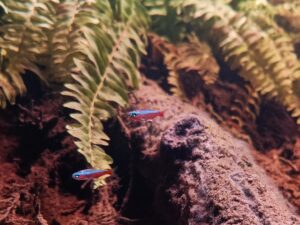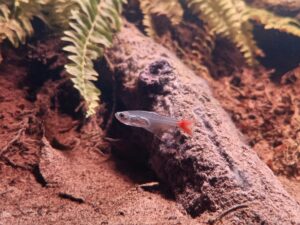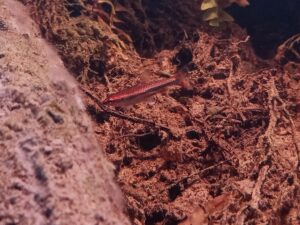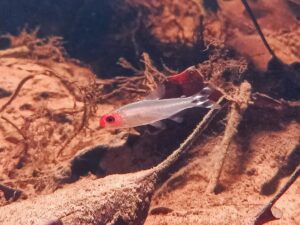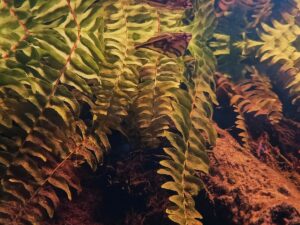First Rain on the banks of the Rio Negro River near Barcelos Municipality, Brazil

Volume of aquarium: 144 L
Dimensions of aquarium: 80×60×30 cm
List of fishes: Carnegiella strigata, Paracheirodon axelrodi, Hemigrammus bleheri, Nannostomus beckfordi, Prionobrama filigera
List of plants: Nephrolepis exaltata var. bostoniens (L.) Darenport
Description of Decorations and Substrate: I used peat soils and pond sludge to simulate the riverbed environment of natural habitats.Also, the leaves were collected in the wild environment, the closest to where they originated.Wood is collected from dry areas near the river bank in the natural environment.The above materials are collected from the natural environment .But the algae and attachments on the riverbed are obtained through the precipitation of time.
Description of Equipment: Heating device:CHANING CN—388 300W ×1
External filter:Filter bucket CHANNING CN—8100 1000L/H ×1
Lighting:Ledesk StarSpec 72W (Color temperature 7495K,wavelength 486.5nm) ×1
Water Parameters: temperature: 27℃, PH:5.0-5.2, GH: 5, TDS: 15
Additional Info: In my fish tank, I use a lot of materials from the natural environment. These materials provide a lot of attachment space for nitrifying bacteria, which is one of the reasons why my water quality is always in good condition. Another reason is that I change 1 / 4 of the water every week, which is also in line with the metabolic law in the natural environment. However, it should be noted that peat soil and pond mud are used in the bottom bed, and the water needs to be replaced very slowly to ensure that the bottom bed will not be damaged. The heating device is turned on for 24 hours to ensure that the temperature in the fish tank is constant. The filter will also be on for 24 hours to ensure the stability of the water quality in the fish tank.
Aquarium video:
Description of the Area Surrounding the Biotope: The Rio Negro River, is the largest tributary of the North Bank of the Amazon River. Its source is the Orinoco River and the Amazon River watershed, it and Orinoco River between the casikiare river. The total length of the Negro River is 2550-2252.6km, the drainage area is 620000 square kilometers, the annual average flow is 30000 cubic meters / second, the average annual runoff depth is 1600mm, and the suspended load concentration is 0.007 kg / m3. The largest tributary of the lower reaches of the Negro River is Rio Branco. The middle and lower tributaries include the mucajai River, ajarani River, anaua River and catrimani river. It flows into the Amazon River 17 kilometers below Manaus. It is about 2000 kilometers long. The river course twists and turns. There are many sandbanks in the lower reaches. The river is 30-50 km wide, like a long lake. Below taprukuala is navigable. Through the Negro River and the kasikyare River, the Amazon River and Orinoco River are connected with each other. The basin is hot, rainy and sparsely populated. The marshes along the coast are humus. One of the small tributaries is barcelos, located near Barcelona. It is located deep in the Amazon rainforest. It is covered with rain and needs to be rowed in by boat. A large amount of driftwood and fallen leaves (close to dense trees) are accumulated underwater, and some soil flows into the river at random.
Description of the Underwater Landscape of the Biotope: In the rainy season of this tributary, the water level rose a lot, and a large amount of river water flooded the trees and weeds near the tributary, which also gave small fish more living space. There are many leaves in the tributary, and the increase of attachments makes small fish have more food. Because of the existence of attachments, the river bottom is light yellow. A large amount of humus darkens the color of the water body. The part near the river bank is much clearer, while the whole tributary is slightly turbid.
Description of the Habitat Parameters: The rainy season starts in September and ends in May. The water temperature is about 26.5-28 ℃. The dry season starts around May and ends from August to September. The water level drops and the temperature rises, and the water temperature is about 28.5-30 ° C. Due to the low water level in the dry season, the pH value in the dry season is about 3.4. The water body in dry season is “black water”, while the water color in rainy season is light yellow.
List of Fishes and Invertebrates Occurring in the Nature Biotope: Crenuchus spilurus
Nanostomus eques, Poecilocharax weitzmani, Liosomadoras oncinus, Dicrossus filamentosus, Crenicichla notophthalmus, Mesonauta festivus, Acarichthys heckelii, Crenicichla marmorata
List of Plants Found in the Nature Biotope: There are no underwater plants in the environment I described, and there are some ferns, trees and weeds on the river bank.
Threats to the Ecology of the Biotope: Because this tributary can only be entered by boat, it has not been cut down and damaged. However, other areas are not so lucky, so I call on people to protect nature. The earth is not just human. As the ruler of the world, what we humans should do is not destroy, but protect. In all my fish tanks, there are often fish looking for mates, mating and breeding without human intervention. All I can do is give these interesting fish a home that belongs to them and is as comfortable as possible.
Sources of Information:
Carnegiella strigata – Marbled Hatchetfish (Gasteropelecus fasciatus, Gasteropelecus strigatus)
Paracheirodon axelrodi – Cardinal Tetra (Cheirodon axelrodi, Hyphessobrycon cardinalis)
Nannostomus beckfordi – Golden Pencilfish (Nannostomus anomalus; Nannostomus aripirangensis)
https://en.wikipedia.org/wiki/Rio_Negro
https://weatherspark.com/y/28529/Average-Weather-in-Barcelos-Brazil-Year-Round

